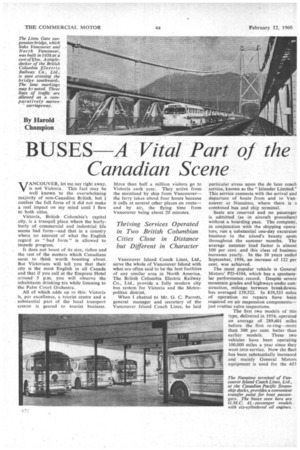ital Part of the Canadian Scene
Page 56

Page 57

If you've noticed an error in this article please click here to report it so we can fix it.
VANCOUVER, let me say right away, is not Victoria. This fact may be well known to the overwhelming majority of non-Canadian British, but I confess the full force of it did not make a real impact on my mind until I flew to both cities.
Victoria, British Columbia's capital city, is a tranquil place where the hurlyburly of commercial and industrial life seems bad form—and that in a country where no amount of what the English regard as "bad form is allowed to impede progress.
It does not boast of its size, riches and the rest of the matters which Canadians seem to think worth boasting about. But Victorians wilt tell you that their city is the most English in all Canada and that if you call at the Empress Hotel around 5 p.m. you will observe the inhabitants drinking tea while listening to the Palm Court Orchestra.
All of which adds up to this: Victoria is, par excellence, a tourist centre and a substantial part of the local transport system is geared to tourist business. More than half a million visitors go to Victoria each year. They arrive from the mainland by ship from Vancouver— the ferry takes about four hours because it calls at several other places en route— and by air, the flying time from Vancouver being about 20 minutes, Vancouver Island Coach Lines, Ltd., serve the whole of Vancouver Island with what are often said to be the best facilities of any similar area in North America, The British Columbia Electric Railway Co., Ltd., provide a fully modern city bus system for Victoria and the Metropolitan district.
When I chatted to Mr. G. C. Parrott, general manager and secretary of the Vancouver Island Coach Lines, he laid particular stress upon the de luxe coach service, known as the " Islander Limited." This service connects with the arrival and departure of boats from and to Vancouver at Nanaimo, where there is a combined bus and ship terminal.
Seats are reserved and no passenger is admitted (as in aircraft procedure) without a boarding pass. The company, in conjunction with the shipping operators, run a substantial one-day excursion business to the island's beauty spots throughout the summer months. The average summer load factor is almost 100 per cent, and this class of business increases yearly. In the 10 years ended September, 1956, an increase of 122 per cent, was achieved.
The most popular vehicle is General Motors' PD-4104, which has a spectacular performance record. Despite severe mountain grades and highways under construction, mileage between breakdowns has averaged 139,522. In 839,333 miles of operation no repairs have been required on air suspension components'— just routine valve inspections.
The first two models of this type, delivered in 1954, operated an average of 289,401 miles before the first re-ring—more than 300 per cent. better than earlier models. These two vehicles have been operating 100,000 miles a year since they went into service. Now the fleet has been substantially increased and mainly General Motors equipment is used for the 453 miles of routes, extending from Victoria to the northern road terminus at Kelsey Bay, from Duncan to the island's West coast, and from Nanaimo to Port Alberni.
The City of Vancouver presents a very different picture, of course. Here is a population of some 600,000 to serve with public transport in a:city with increasing industries and commerce. As in Victoria, the local system is owned by the British Columbia Power Corporation, an organization of wide interests, whose new 21-storey head office, built by a British firm of contractors is one of Vancouver's chief landmarks.
They also own Pacific Stage Lines, which have routes stretching as far as Hope, 100 miles out of Vancouver, and a total route-mileage of 427. In the city, basically three types of coach are used. There are 10 old General Motors vehicles, some Twin Coaches made by Fageol, Kent of Ohio, and Canadian Car, a subsidiary of the British concern, A. V. Roe. Pacific Stage Lines use Canadian Car as the backbone of the fleet but they continue to operate a few Twin Coaches and Fitzjohns, In Vancouver City there is one fare only (with few exceptions)-13 cents. Today buses and trolfeybuses only are used. Trams (or-street cars, as they are known in North America) were progressively withdrawn from 1948 and finally abolished in 1954. In 1957, urban passenger revenues totalled nearly £5,000,000 and in covering a total of 231 million miles, 1034 million passengers were carried. Altogether, the British Columbia Power Corporation operate 242 vehicles in Vancouver City on local routes, 69 on services run by Pacific Stage Lines, and 98 in Victoria, a total of 409 buses. From all its urban road services, the Corporation earned 5L2 cents passenger revenue per mile.
Comparing Vancouver's new Canadian Car coaches with London's doubledeckers, I asked whether the growing population did not demand larger vehicles. Mr. S. Sigmundson, who heads the system, told me that with their specially wide aisle-102 inches--these buses will take loadings of up to 80 in the rush hours, though their seating capacity is only 52.




















































































































